MICROCHIP MCP39F521 Power Monitor Demonstration Board
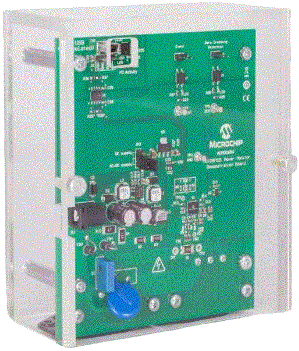
Product Information
Specifications
- Product Name: MCP39F521 Power Monitor Demonstration Board
- Manufacturer: Microchip Technology Inc.
- Model Number: DS50002413A
- Certification: ISO/TS 16949
- Trademark Information: Various trademarks registered by Microchip Technology Inc.
- ISBN: 978-1-63277-821-5
Preface
NOTICE TO CUSTOMERS
- All documentation becomes dated, and this manual is no exception. Microchip tools and documentation are constantly evolving to meet customer needs, so some actual dialogs and/or tool descriptions may differ from those in this document. Please refer to our web site (www.microchip.com) to obtain the latest documentation available.
- Documents are identified with a “DS” number. This number is located on the bottom of each page, in front of the page number. The numbering convention for the DS number is “DSXXXXXXXXA”, where “XXXXXXXX” is the document number and “A” is the revision level of the document.
- For the most up-to-date information on development tools, see the MPLAB® IDE online help. Select the Help menu, and then Topics to open a list of available online help files.
INTRODUCTION
This chapter contains general information that will be useful to know before using the MCP39F521 Power Monitor Demonstration Board. Items discussed in this chapter include:
- Document Layout
- Conventions Used in this Guide
- Recommended Reading
- The Microchip Web Site
- Customer Support
- Document Revision History
DOCUMENT LAYOUT
This document describes how to use the MCP39F521 Power Monitor Demonstration Board to evaluate the MCP39F521 device. The manual layout is as follows:
- Chapter 1. “Product Overview” – Provides important information about the MCP39F521 Power Monitor Demonstration Board
- Chapter 2. “Installation and Operation” – Provides information on using the MCP39F521 Power Monitor Demonstration Board, including Section 2.1.1 that describes wiring the line and load connections
- Chapter 3. “Hardware Description” – Provides details on the functional blocks of the power monitor, including the analog front-end design and power supply design
- Appendix A. “Schematic and Layouts” – Shows the schematic and layout diagrams
- Appendix B. “Bill of Materials (BOM)” – Lists the parts used to build the MCP39F521 Power Monitor Demonstration Board
CONVENTIONS USED IN THIS GUIDE
This manual uses the following documentation conventions:
DOCUMENTATION CONVENTIONS
| Description | Represents | Examples |
| Arial font: | ||
| Italic characters | Referenced books | MPLAB® IDE User’s Guide |
| Emphasized text | …is the only compiler… | |
| Initial caps | A window | the Output window |
| A dialog | the Settings dialog | |
| A menu selection | select Enable Programmer | |
| Quotes | A field name in a window or dialog | “Save project before build” |
| Underlined, italic text with right angle bracket | A menu path | File>Save |
| Bold characters | A dialog button | Click OK |
| A tab | Click the Power tab | |
| N‘Rnnnn | A number in verilog format, where N is the total number of digits, R is the radix and n is a digit. | 4‘b0010, 2‘hF1 |
| Text in angle brackets < > | A key on the keyboard | Press <Enter>, <F1> |
| Courier New font: | ||
| Plain Courier New | Sample source code | #define START |
| Filenames | autoexec.bat | |
| File paths | c:\mcc18\h | |
| Keywords | _asm, _endasm, static | |
| Command-line options | -Opa+, -Opa- | |
| Bit values | 0, 1 | |
| Constants | 0xFF, ‘A’ | |
| Italic Courier New | A variable argument | file.o, where file can be any valid filename |
| Square brackets [ ] | Optional arguments | mcc18 [options] file [options] |
| Curly brackets and pipe character: { | } | Choice of mutually exclusive arguments; an OR selection | error level {0|1} |
| Ellipses… | Replaces repeated text | var_name [, var_name…] |
| Represents code supplied by user | void main (void)
{ … } |
|
RECOMMENDED READING
- This user’s guide describes how to use the MCP39F521 Power Monitor Demonstration Board. Other useful documents are listed below. The following Microchip documents are available and recommended as supplemental reference resources.
- MCP39F521 Data Sheet – “I2CSingle Phase Energy and Power Monitoring IC with Calculation” (DS20005442)
- This data sheet provides detailed information regarding the MCP39F521 device.
THE MICROCHIP WEB SITE
Microchip provides online support via our web site at www.microchip.com. This web site is used as a means to make files and information easily available to customers. Accessible by using your favorite Internet browser, the web site contains the following information:
- Product Support – Data sheets and errata, application notes and sample programs, design resources, user’s guides and hardware support documents, latest software releases and archived software
- General Technical Support – Frequently Asked Questions (FAQs), technical support requests, online discussion groups, Microchip consultant program member listing
- Business of Microchip – Product selector and ordering guides, latest Microchip press releases, listing of seminars and events, listings of Microchip sales offices, distributors and factory representatives
CUSTOMER SUPPORT
Users of Microchip products can receive assistance through several channels:
- Distributor or Representative
- Local Sales Office
- Field Application Engineer (FAE)
- Technical Support
- Customers should contact their distributor, representative or field application engineer (FAE) for support. Local sales offices are also available to help customers. A listing of sales offices and locations is included in the back of this document.
- Technical support is available through the web site at: http://support.microchip.com
DOCUMENT REVISION HISTORY
Revision A (September 2015)
Initial release of this document.
Chapter 1. Product Overview
INTRODUCTION
- The MCP39F521 Power Monitor Demonstration Board is a fully functional single-phase power and energy monitor. The system calculates active power, reactive power, RMS current, RMS voltage, active energy (both import and export), reactive energy and other typical power quantities as defined in the MCP39F521 data sheet.
- The “MCP39F521 Power Monitor Utility” software is used to calibrate and monitor the system, and can be used to create custom calibration setups. For most accuracy requirements, only a single-point calibration is needed. The energy meter software offers an automated step-by-step calibration process that can be used to quickly calibrate energy meters.
- This demonstration board uses the MCP39F521 Power Monitor Utility software for evaluation via a USB connection to the board. A download link for this software can be found on the evaluation board’s web page. For instructions on the use of this software, refer to the software’s supporting documentation included within the application install package.
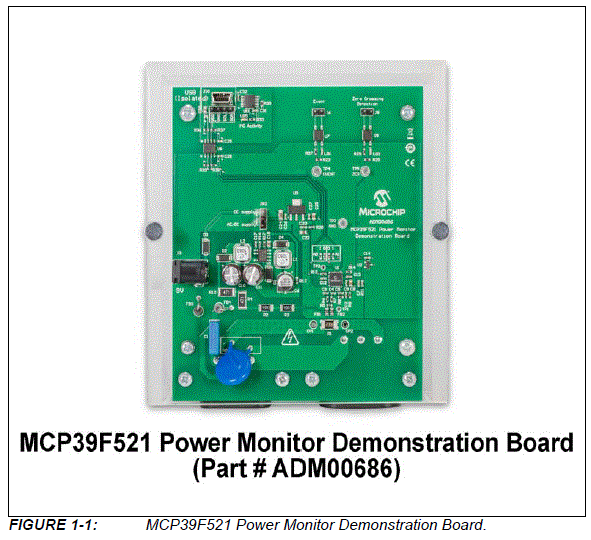
WHAT THE MCP39F521 POWER MONITOR DEMONSTRATION BOARD KIT INCLUDES
This MCP39F521 Power Monitor Demonstration Board kit includes:
- MCP39F521 Power Monitor Demonstration Board (ADM00686)
- AC Line Cable
- IEC-to-Female AC Load Cable
- Mini-USB Cable
- Important Information Sheet
Chapter 2. Installation and Operation
GETTING STARTED
- To use the MCP39F521 Power Monitor Demonstration Board, follow the steps described in the following sections. The meter design uses a 5A load for calibration current and a maximum current (IMAX) of 15A.
- It is not recommended to put more than 15A through the AC plugs mounted on the Printed Circuit Board (PCB).
- To test the calibrated meter, the following connections can be made:
Step 1: Wiring connections
Figure 2-1 identifies the line and load connections of the MCP39F521 Power Monitor Demonstration Board.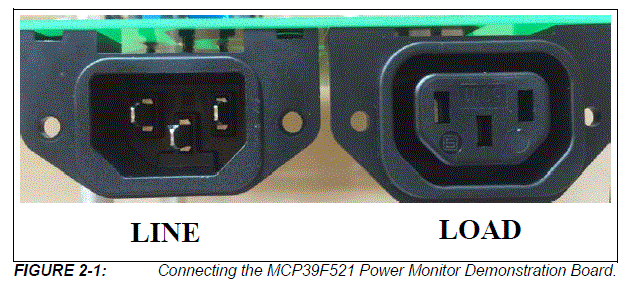
Step 2: Turn on line/load power to the meter (power the meter)
The meter will turn on when the line connection is powered by 90V to 220V.
Step 3: Connect the USB cable to a PC with the installed “MCP39F521 Power Monitor Utility” software
Select the appropriate COM port. If the meter is connected correctly, the connection status in the bottom-left corner of the software will display “Meter Connected”. If no meter is found, the status will be “Meter Disconnected”. Check that the correct COM port was selected and try again. Press the “Start” Icon to begin showing output data and UART transmission between the PC and the MCP39F521.
Chapter 3. Hardware Description
This chapter identifies the main features of the MCP39F521 board and describes the circuits. Figure 3-1 illustrates the components on the top view.
Legend:
- USB Connection (isolated)
- Event Digital Output
- Zero Cross Digital Output
- Header for connection to external master MCU (isolated)
- Isolation IC
- Jumper for DC or Switching AC/DC Supply
- Switching ACIDC Power Supply
- +9V DC Input (non-isolated)
- 1000: 1 Voltage Divider for Voltage Input
- Connections to external shunt current sensing resistor
- MCP39F521
Figure 3-2 illustrates the components on the board’s bottom view. Legend:
Legend: - Load connection (15A maximum recommended current)
- Line connection AC supply (90-230V)
INPUT AND ANALOG FRONT END
- The MCP39F521 Power Monitor Demonstration Board will operate from 90V to 230V. At the bottom of the main board are the high-voltage line and neutral connections. The shunt sits on the neutral side, or low side, of a two-wire system. The board comes populated with a surface mount 2 mΩ shunt. If a lower value external shunt is to be used, the wires going from the external shunt to the CP1 and CP2 connections should twisted together.
- The neutral side of the two-wire system goes into a resistor divider on the voltage channel input, along with a DC offset added from VDD. Anti-aliasing low-pass filters are included. The voltage channel uses two 499 kΩ resistors to achieve a divider ratio of 1000:1. For a line voltage of 220 VRMS, the channel 1 input signal size will be 220 mVRMS.
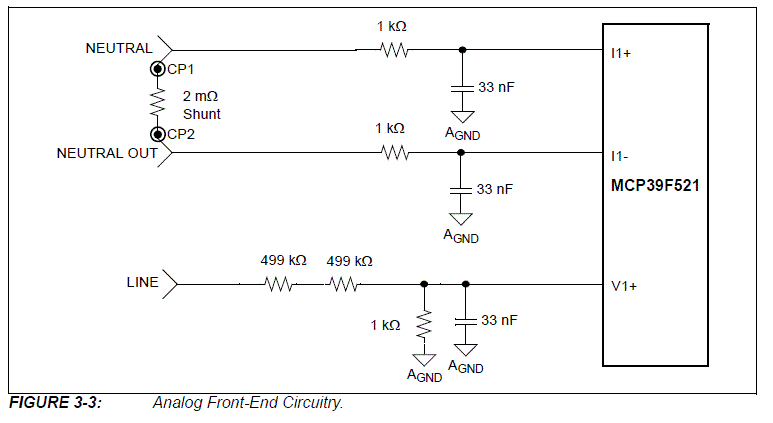
Note that all of the analog circuitry associated with this part of the circuit is connected to the analog ground plane (AGND).
POWER SUPPLY CIRCUIT
The power supply circuit for the MCP39F521 Power Monitor Demonstration Board is shown in Figure 3-4.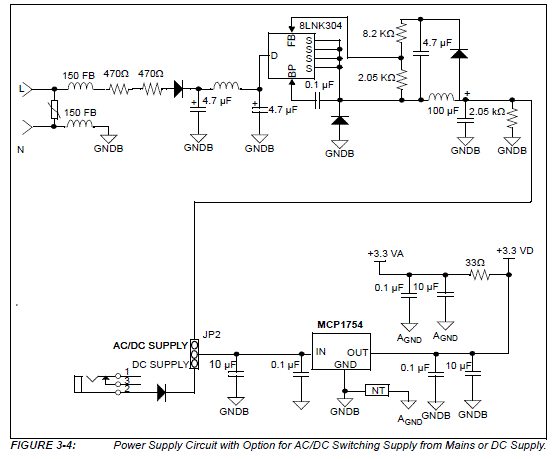
Appendix
Appendix A. Schematic and Layouts
INTRODUCTION
This appendix contains the following schematics and layouts for of the MCP39F521 Power Monitor Demonstration Board:
- Board – MCP39F521 Schematic
- Board – Power and USB Schematic
- Board – Top Silk
- Board – Top Copper and Silk
- Board – Top Copper
- Board – Bottom Copper
- Board – Bottom Copper and Silk
- Board – Bottom Silk
SCHEMATICS AND PCB LAYOUT
The layer order is shown in Figure A-1.
MCP39F521 Power Monitor Demonstration Board Us-
BOARD – MCP39F521 SCHEMATIC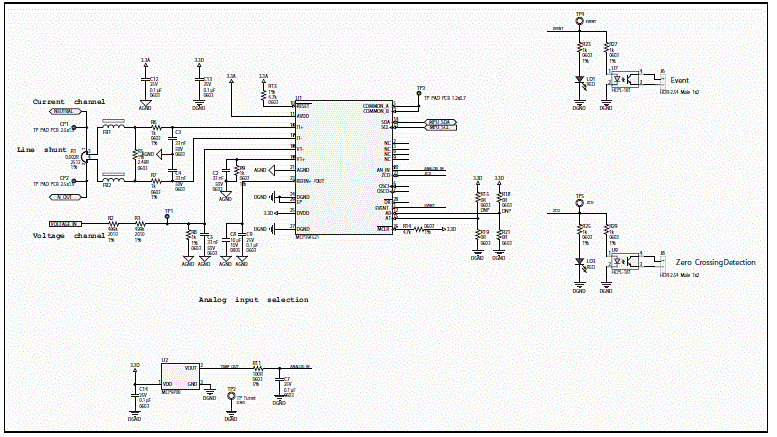
Schematic and Layouts
BOARD – POWER AND USB SCHEMATIC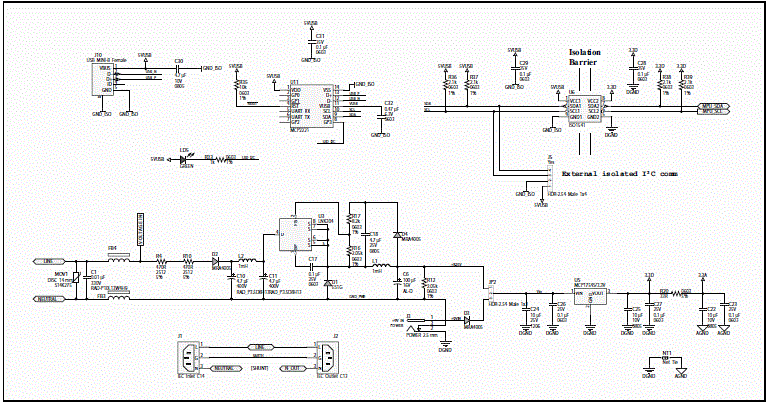
BOARD – TOP SILK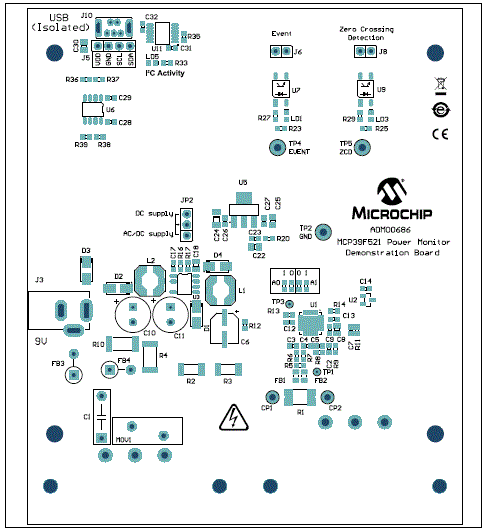
BOARD – TOP COPPER AND SILK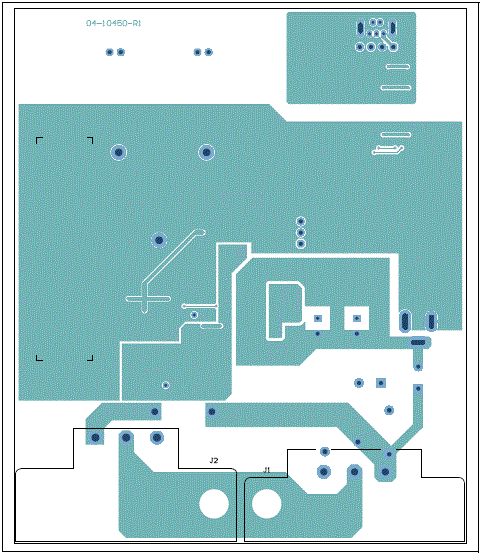
BOARD – TOP COPPER
BOARD – BOTTOM COPPER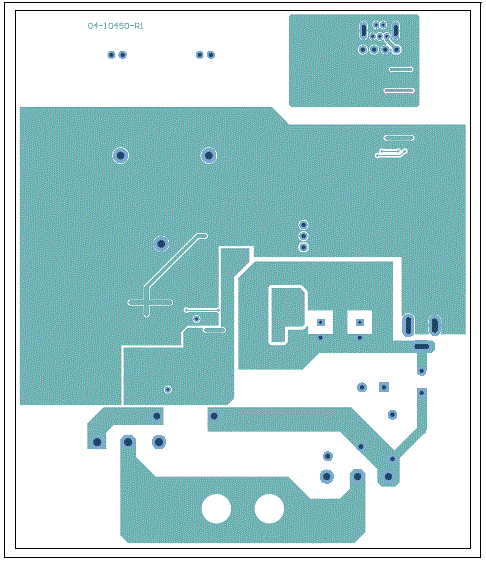
BOARD – BOTTOM COPPER AND SILK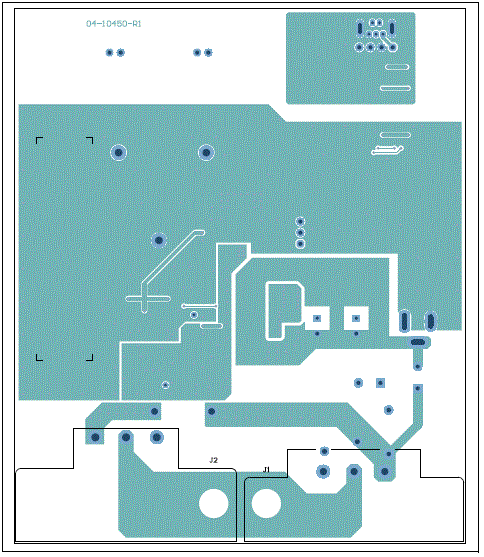
BOARD – BOTTOM SILK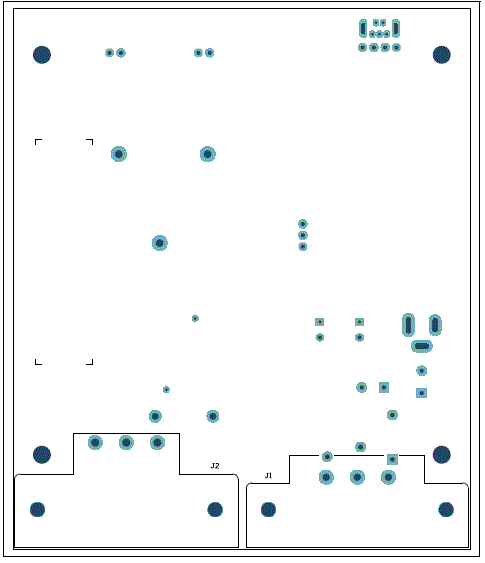
Appendix B. Bill of Materials (BOM)
TABLE B-1: BILL OF MATERIALS (BOM)
| Qty. | Designator | Description | Manufacturer | Part Number |
| 1 | C1 | Cap. film 0.01 µF 330V 20% RAD P10L13W4H9 | EPCOS AG | B32911A3103M |
| 4 | C2, C3, C4, C5 | Cap. ceramic 33 nF 50V 10% X7R SMD 0603 | TDK Corporation | C1608X7R1H333K |
| 1 | C6 | Cap. aluminum 100 µF 16V 20% SMD D | Nichicon Corporation | UWX1C101MCL1GB |
| 12 | C7, C9, C12, C13, C14, C17, C23, C26, C27, C28, C29, C31 | Cap. ceramic 0.1 µF 25V 10% X7R SMD 0603 | Murata Electronics® | GRM188R71E104KA01D |
| 3 | C8, C22, C25 | Cap. ceramic 10 µF 10V 10% X7R SMD 0805 | TDK Corporation | C2012X7R1A106K125AC |
| 2 | C10, C11 | Cap. aluminum 4.7 µF 400V 20% RAD_P3.5D8H13 | Nichicon Corporation | ‘UVC2G4R7MPD1TD |
| 1 | C18 | Cap. ceramic 4.7 µF 25V 10% X7R SMD 0805 | TDK Corporation | C2012X7R1E475K125AB |
| 1 | C24 | Cap. ceramic 10 µF 25V 10% X7R SMD 1206 | Taiyo Yuden Co., Ltd. | MK316B7106KL-TD |
| 1 | C30 | Cap. ceramic 4.7 µF 10V 10% X5R SMD 0805 | Taiyo Yuden Co., Ltd. | LMK212BJ475KD-T |
| 1 | C32 | Cap. ceramic 0.47 µF 6.3V 10% X5R SMD 0603 | Murata Electronics | GRM188R60J474KA01D |
| 1 | D1 | Diode rec. ES1G 1.25V 1A 400V SMD DO-214AC_SMA | Diodes® Incorporated | ES1G-13-F |
| 3 | D2, D3, D4 | Diode rec. MRA4005 1.1V 1A 600V DO-214AC_SMA | ON Semiconductor® | MRA4005T3G |
| 2 | FB1, FB2 | Ferrite 800 mA 0.15R SMD 0805 | Laird Technologies® | LI0805H151R-10 |
| 2 | FB3, FB4 | Ferrite 7A 0.01R RAD P5L5.3D3.8 | Panasonic® – ECG | EXC-ELSR35S |
| 1 | J1 | Conn. IEC 250V 15A Inlet C14 TH R/A | SCHURTER Inc. | GSP1.9103.1 |
| 1 | J2 | Conn. IEC 250V 15A Outlet C13 TH R/A | SCHURTER Inc. | 6182.0033 |
| 1 | J3 | Conn. Power 2.5 mm 5.5 mm Switch TH R/A | CUI Inc. | PJ-002B |
| 1 | J5 | Conn. Header-2.54 Male 1×4 Tin
5.84 MH TH Vert. |
FCI | 68002-404HLF |
| 2 | J6, J8 | Conn. Header-2.54 Male 1×2 Tin
6.10 MH TH Vert. |
Molex® | 0022284020 |
| 1 | J10 | Conn. Header-2.54 Male 1×2 Tin
6.10 MH TH Vert. |
Molex | 500075-1517 |
| 1 | JP2 | Conn. Header-2.54 Male 1×3 Gold
5.84 MH TH Vert. |
FCI | 68000-103HLF |
Note 1: The components listed in this Bill of Materials are representative of the PCB assembly. The released BOM used in manufacturing uses all RoHS-compliant components.
| Qty. | Designator | Description | Manufacturer | Part Number |
| 3 | JP4 | Mech. HW Jumper 2.54 mm 1×2 Handle Gold | TE Connectivity, Ltd. | 881545-2 |
| 2 | L1, L2 | Inductor 1 mH 240 mA 20% SMD L6W6H2.4 | Coilcraft | LPS6225-105MLB |
| 2 | LD1, LD3 | Diode LED red 1.95V 30 mA 700 mcd Clear SMD 0603 | Kingbright Corp. | APTD1608SURCK |
| 1 | LD5 | Diode LED green 2V 30 mA 35 mcd Clear SMD 0603 | Lite-On® Technology Corporation | LTST-C190KGKT |
| 1 | MOV1 | Res. Varistor 275V 130J TH DISC 14 mm | EPCOS AG | S14K275E2K1 |
| 1 | PCB | MCP39F521 Printed Circuit Board | — | 04-00686-R1 |
| 1 | R1 | Res. Shunt MF 0.002R 1% 2W 2512 | Stackpole Electronics, Inc. | CSNL2512FT2L00 |
| 2 | R2, R3 | Res. TKF 499k 1% 3/4W SMD 2010 | Vishay/Dale | CRCW2010499KFKEF |
| 2 | R4, R10 | Res. TKF 470R 5% 1W SMD 2512 | Panasonic – ECG | ERJ-1TYJ471U |
| 1 | R5 | Res. TKF 2.49R 1% 1/10W SMD 0603 | Vishay Intertechnology, Inc. | CRCW06032R49FKEA |
| 9 | R6, R7, R8, R9, R23, R25, R27, R29, R33 | Res. TKF 1k 1% 1/10W SMD 0603 | Panasonic – ECG | ERJ-3EKF1001V |
| 1 | R11 | Res. TKF 100R 5% 1/10W SMD 0603 | Vishay Intertechnology, Inc. | CRCW0603100RJNEA |
| 2 | R12, R16 | Res. TKF 2.05k 1% 1/10W SMD 0603 | Yageo Corporation | RC0603FR-072K05L |
| 2 | R13, R14 | Res. TKF 4.7k 1% 1/10W SMD 0603 | Panasonic – ECG | ERJ-3EKF4701V |
| 2 | R15, R18 | Res. TKF 0R 1/10W SMD 0603 | NIC Components Corp. | NRC06Z0TRF |
| 1 | R17 | Res. TKF 8.2k 1% 1/10W SMD 0603 | Panasonic – ECG | ERJ-3EKF8201V |
| 2 | R19, R21 | Res. TKF 0R 1/10W SMD 0603 | NIC Components Corp. | NRC06Z0TRF |
| 1 | R20 | Res. TKF 33R 5% 1/10W SMD 0603 | Yageo Corporation | 9C06031A33R0JLHFT |
| 1 | R35 | Res. TKF 10k 1% 1/10W SMD 0603 | Panasonic – ECG | ERJ-3EKF1002V |
| 4 | R36, R37, R38, R39 | Res. TKF 2.1k 1% 1/10W SMD 0603 | Panasonic – ECG | ERJ-3EKF2101V |
| 3 | TP2, TP4, TP5 | Conn. TP Pin Tin TH | Harwin Plc. | H2121-01 |
| 1 | U1 | MCHP Analog Energy Measurement 4000:1 MCP39F521-E/MQ QFN-28 | Microchip Technology, Inc. | MCP39F521-E/MQ |
| 1 | U2 | MCHP Analog Temperature Sensor
-40°C to +150°C MCP9700T-E/TT SOT-23-3 |
Microchip Technology Inc. | MCP9700T-E/TT |
| 1 | U3 | IC Switcher LNK304 SO-8C | Power Integrations™ | LNK304DG-TL |
| 1 | U5 | MCHP Analog LDO 3.3V MCP1754ST-3302E/DB SOT-223-3 | Microchip Technology Inc. | MCP1754ST-3302E/DB |
| 1 | U6 | IC Isolator ISO1541DR Bidirectional I2C SOIC-8 | Texas Instruments | SO1541DR |
| 2 | U7, U9 | IC Photo HCPL-181 4-SMD | Avago Technologies | HCPL-181-00CE |
| 1 | U11 | MCHP Interface USB I2C UART MCP2221-I/ST TSSOP-14 | Microchip Technology Inc. | MCP2221-I/ST |
Note 1: The components listed in this Bill of Materials are representative of the PCB assembly. The released BOM used in manufacturing uses all RoHS-compliant components.
| Qty. | Designator | Description | Manufacturer | Par Number |
| 4 | NUT1 | Hex Nut 5/16″ 6-32 | B&F™ Fasteners Supply | HNZ 632 |
| 4 | SCR1 | Machine Screw Pan Phillips 6-32 | B&F Fasteners Supply | PMS 632 0038 PH |
Note 1: The components listed in this Bill of Materials are representative of the PCB assembly. The released BOM used in manufacturing uses all RoHS-compliant components.
Worldwide Sales and Service
AMERICAS
- Corporate Office
- 2355 West Chandler Blvd. Chandler, AZ 85224-6199
- Tel: 480-792-7200
- Fax: 480-792-7277
- Technical Support: http://www.microchip.com/support
- Web Address: www.microchip.com
Note the following details of the code protection feature on Microchip devices:
- Microchip products meet the specification contained in their particular Microchip Data Sheet.
- Microchip believes that its family of products is one of the most secure families of its kind on the market today, when used in the intended manner and under normal conditions.
- There are dishonest and possibly illegal methods used to breach the code protection feature. All of these methods, to our knowledge, require using the Microchip products in a manner outside the operating specifications contained in Microchip’s Data Sheets. Most likely, the person doing so is engaged in theft of intellectual property.
- Microchip is willing to work with the customer who is concerned about the integrity of their code.
- Neither Microchip nor any other semiconductor manufacturer can guarantee the security of their code. Code protection does not mean that we are guaranteeing the product as “unbreakable.”
Code protection is constantly evolving. We at Microchip are committed to continuously improving the code protection features of our products. Attempts to break Microchip’s code protection feature may be a violation of the Digital Millennium Copyright Act. If such acts allow unauthorized access to your software or other copyrighted work, you may have a right to sue for relief under that Act.
Information contained in this publication regarding device applications and the like is provided only for your convenience and may be superseded by updates. It is your responsibility to ensure that your application meets with your specifications. MICROCHIP MAKES NO REPRESENTATIONS OR WARRANTIES OF ANY KIND WHETHER EXPRESS OR IMPLIED, WRITTEN OR ORAL, STATUTORY OR OTHERWISE, RELATED TO THE INFORMATION, INCLUDING BUT NOT LIMITED TO ITS CONDITION, QUALITY, PERFORMANCE, MERCHANTABILITY OR FITNESS FOR PURPOSE. Microchip disclaims all liability arising from this information and its use. Use of Microchip devices in life support and/or safety applications is entirely at the buyer’s risk, and the buyer agrees to defend, indemnify and hold harmless Microchip from any and all damages, claims, suits, or expenses resulting from such use. No licenses are conveyed, implicitly or otherwise, under any Microchip intellectual property rights unless otherwise stated.
Trademarks
- The Microchip name and logo, the Microchip logo, dsPIC, FlashFlex, flexPWR, JukeBlox, KEELOQ, KEELOQ logo, Kleer, LANCheck, MediaLB, MOST, MOST logo, MPLAB, OptoLyzer, PIC, PICSTART, PIC32 logo, RightTouch, SpyNIC, SST, SST Logo, SuperFlash and UNI/O are registered trademarks of Microchip Technology Incorporated in the U.S.A. and other countries.
- The Embedded Control Solutions Company and mTouch are registered trademarks of Microchip Technology Incorporated in the U.S.A.
Analog-for-the-Digital Age, BodyCom, chipKIT, chipKIT logo, CodeGuard, dsPICDEM, dsPICDEM.net, ECAN, In-Circuit Serial Programming, ICSP, Inter-Chip Connectivity, KleerNet, KleerNet logo, MiWi, motorBench, MPASM, MPF, MPLAB Certified logo, MPLIB, MPLINK, MultiTRAK, NetDetach, Omniscient Code Generation, PICDEM, PICDEM.net, PICkit, PICtail, RightTouch logo, REAL ICE, SQI, Serial Quad I/O, Total Endurance, TSHARC, USBCheck, VariSense, ViewSpan, WiperLock, Wireless DNA, and ZENA are trademarks of Microchip Technology Incorporated in the
U.S.A. and other countries. - SQTP is a service mark of Microchip Technology Incorporated in the U.S.A.
- Silicon Storage Technology is a registered trademark of Microchip Technology Inc. in other countries.
- GestIC is a registered trademark of Microchip Technology Germany II GmbH & Co. KG, a subsidiary of Microchip Technology Inc., in other countries.
- All other trademarks mentioned herein are property of their respective companies.
- © 2015, Microchip Technology Incorporated, Printed in the U.S.A., All Rights Reserved.
- ISBN: 978-1-63277-821-5
QUALITY MANAGEMENT SYSTEM CERTIFIED BY DNV
== ISO/TS 16949 ==
Microchip received ISO/TS-16949:2009 certification for its worldwide headquarters, design and wafer fabrication facilities in Chandler and Tempe, Arizona; Gresham, Oregon and design centers in California and India. The Company’s quality system processes and procedures are for its PIC® MCUs and dsPIC® DSCs, KEELOQ® code hopping devices, Serial EEPROMs, microperipherals, nonvolatile memory and analog products. In addition, Microchip’s quality system for the design and manufacture of development systems is ISO 9001:2000 certified.
Object of Declaration: MCP39F521 Power Monitor Demonstration Board
EU Declaration of Conformity
Manufacturer:
- Microchip Technology Inc.
- 2355 W. Chandler Blvd.
- Chandler, Arizona, 85224-6199
- USA
This declaration of conformity is issued by the manufacturer.
- The development/evaluation tool is designed to be used for research and development in a laboratory environment. This development/evaluation tool is not intended to be a finished appliance, nor is it intended for incorporation into finished appliances that are made commercially available as single functional units to end users. This development/evaluation tool complies with EU EMC Directive 2004/108/EC and as supported by the European Commission’s Guide for the EMC Directive 2004/108/EC (8th February 2010).
- This development/evaluation tool complies with EU RoHS2 Directive 2011/65/EU.
- This development/evaluation tool, when incorporating wireless and radio-telecom functionality, is in compliance with the essential requirement and other relevant provisions of the R&TTE Directive 1999/5/EC and the FCC rules as stated in the declaration of conformity provided in the module datasheet and the module product page available at www.microchip.com.
- For information regarding the exclusive, limited warranties applicable to Microchip products, please see
- Microchip’s standard terms and conditions of sale, which are printed on our sales documentation and available at www.microchip.com.
- Signed for and on behalf of Microchip Technology Inc. at Chandler, Arizona, USA

FAQ
What should I do if I encounter issues with the MCP39F521 Power Monitor Demonstration Board?
If you face any difficulties or have questions regarding the board's operation, refer to the user manual for troubleshooting tips. You can also reach out to Microchip Technology Inc. for further assistance.
Can I modify the MCP39F521 Power Monitor Demonstration Board?
While modifications are possible, it is recommended to follow the guidelines provided in the user manual to ensure proper functioning and accurate evaluation of the MCP39F521 IC.
Documents / Resources
 |
MICROCHIP MCP39F521 Power Monitor Demonstration Board [pdf] User Guide DS50002413A, DS50002413, 50002413A, 50002413, MCP39F521 Power Monitor Demonstration Board, MCP39F521, Power Monitor Demonstration Board, Monitor Demonstration Board, Demonstration Board, Board |